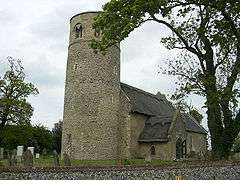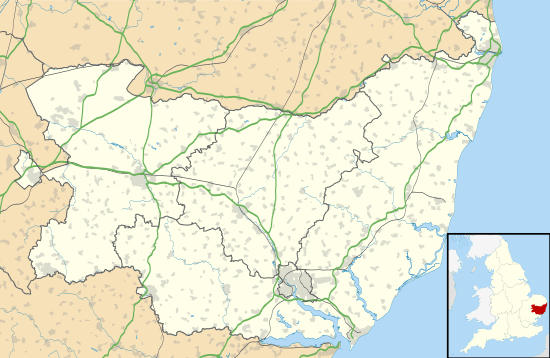Herringfleet
Herringfleet is a small village and former civil parish, now in the parish of Somerleyton, Ashby and Herringfleet, in the East Suffolk district, in the county of Suffolk, England. It lies on the River Waveney, between Somerleyton and St. Olaves within The Broads National Park. In 1961 the parish had a population of 262.[1] In 1987 the parish was merged with Ashby and Somerleyton to form "Somerleyton, Ashby and Herringfleet".[2]
| Herringfleet | |
|---|---|
 Herringfleet St. Margaret | |
 Herringfleet Location within Suffolk | |
| Civil parish | |
| District |
|
| Shire county | |
| Region | |
| Country | England |
| Sovereign state | United Kingdom |
| Post town | Lowestoft |
| Postcode district | NR32 |
Herringfleet was occupied by the Roman Empire, and archaeologists have made numerous finds, including a Roman bronze 'patera', a 'soup ladle' vessel with the maker's name 'Quattenus' on the handle, and a Roman nether mill-stone of trachyte, originally imported from Saxony or Koblenz on the Rhine.
In the Middle Ages, Herringfleet was governed by the St Olaves Priory. Herringfleet is known for its Norman church, built in several parts over the past millennia. Its round tower is indicative of many East Anglian churches dating from the period. The church includes a nave and chancel. The whole edifice is of Norman architecture, though considerable alterations have been made. The tower retains most of its original features, and has in the upper story wide windows of two lights, which are triangular-headed.[3]
Herringfleet Mill is a timber smock drainpipe windpump grade 2 building which is now in a state of decay and has had two of its four sails removed. There is also evidence of a Saxon manor house on the site of the present-day Manor Farm.
References
- "Population Statistics Herringfleet CP/AP through time". A Vision of Britain. Retrieved 25 January 2020.
- "The Waveney (Parishes) Order 1987" (PDF). Local Government Boundary Commission for England. Retrieved 25 January 2020.
- England (1855). The ecclesiastical and architectural topography of England. Bedfordshire (Berkshire, Buckinghamshire, Cambridgeshire, Huntingdonshire, Oxfordshire, Suffolk) (Public domain ed.). pp. 122–. Retrieved 3 December 2011.